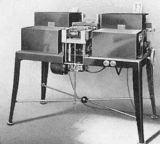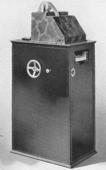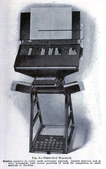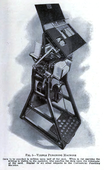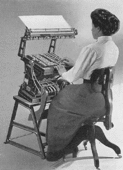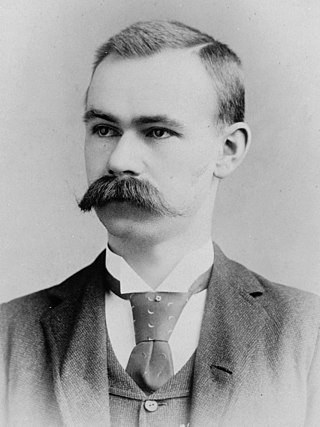
Herman Hollerith was a German-American statistician, inventor, and businessman who developed an electromechanical tabulating machine for punched cards to assist in summarizing information and, later, in accounting. His invention of the punched card tabulating machine, patented in 1884, marks the beginning of the era of mechanized binary code and semiautomatic data processing systems, and his concept dominated that landscape for nearly a century.

A punched card is a piece of card stock that stores digital data using punched holes. Punched cards were once common in data processing and the control of automated machines.
Data processing is the collection and manipulation of digital data to produce meaningful information. Data processing is a form of information processing, which is the modification (processing) of information in any manner detectable by an observer.
A voting machine is a machine used to record votes in an election without paper. The first voting machines were mechanical but it is increasingly more common to use electronic voting machines. Traditionally, a voting machine has been defined by its mechanism, and whether the system tallies votes at each voting location, or centrally. Voting machines should not be confused with tabulating machines, which count votes done by paper ballot.
Electronic data processing (EDP) or business information processing can refer to the use of automated methods to process commercial data. Typically, this uses relatively simple, repetitive activities to process large volumes of similar information. For example: stock updates applied to an inventory, banking transactions applied to account and customer master files, booking and ticketing transactions to an airline's reservation system, billing for utility services. The modifier "electronic" or "automatic" was used with "data processing" (DP), especially c. 1960, to distinguish human clerical data processing from that done by computer.

The Powers Accounting Machine was an information processing device developed in the early 20th century for the U.S. Census Bureau. It was then produced and marketed by the Powers Accounting Machine Company, an information technology company founded by the machine's developer. The company thrived in the early 20th century as a producer of tabulating machines. It was a predecessor to the Unisys corporation.

Starting at the end of the nineteenth century, well before the advent of electronic computers, data processing was performed using electromechanical machines collectively referred to as unit record equipment, electric accounting machines (EAM) or tabulating machines. Unit record machines came to be as ubiquitous in industry and government in the first two-thirds of the twentieth century as computers became in the last third. They allowed large volume, sophisticated data-processing tasks to be accomplished before electronic computers were invented and while they were still in their infancy. This data processing was accomplished by processing punched cards through various unit record machines in a carefully choreographed progression. This progression, or flow, from machine to machine was often planned and documented with detailed flowcharts that used standardized symbols for documents and the various machine functions. All but the earliest machines had high-speed mechanical feeders to process cards at rates from around 100 to 2,000 per minute, sensing punched holes with mechanical, electrical, or, later, optical sensors. The operation of many machines was directed by the use of a removable plugboard, control panel, or connection box. Initially all machines were manual or electromechanical. The first use of an electronic component was in 1937 when a photocell was used in a Social Security bill-feed machine. Electronic components were used on other machines beginning in the late 1940s.

The Friden Flexowriter was a teleprinter produced by the Friden Calculating Machine Company. It was a heavy-duty electric typewriter capable of being driven not only by a human typing, but also automatically by several methods, including direct attachment to a computer and by use of paper tape.

A keypunch is a device for precisely punching holes into stiff paper cards at specific locations as determined by keys struck by a human operator. Other devices included here for that same function include the gang punch, the pantograph punch, and the stamp. The term was also used for similar machines used by humans to transcribe data onto punched tape media.

The IBM 407 Accounting Machine, introduced in 1949, was one of a long line of IBM tabulating machines dating back to the days of Herman Hollerith. It had a card reader and printer; a summary punch could be attached. Processing was directed by a control panel.

The tabulating machine was an electromechanical machine designed to assist in summarizing information stored on punched cards. Invented by Herman Hollerith, the machine was developed to help process data for the 1890 U.S. Census. Later models were widely used for business applications such as accounting and inventory control. It spawned a class of machines, known as unit record equipment, and the data processing industry.

Fredrik Rosing Bull was a Norwegian scientist, information technology pioneer, known for his work on improved punched card machines. Bull was born in Kristiania. In 1907, he finished his studies in civil engineering at the Technical School of Kristiania. In 1916, he was hired as a technical inspector for the insurance company Storebrand, where he developed an interest for punched card technology and began developing one of his own. In 1919, he obtained a patent for his machine, and in 1921 he prepared a team that took over the implementation of the machine at Storebrand. This team provided several new ideas for improving the Bull machine, rendering it superior to Herman Hollerith's device, the precursor to the IBM punched card machine, in use at that time. Bull continued to develop his ideas and improve the machine, which became a success throughout Europe. He was diagnosed with cancer in 1924 and died in 1925 at the age of 42. His patents were later sold in 1931 and constituted the basis for the founding of the French company Groupe Bull, a large information technology company operating in over 100 countries.
The British Tabulating Machine Company (BTM) was a firm which manufactured and sold Hollerith unit record equipment and other data-processing equipment. During World War II, BTM constructed some 200 "bombes", machines used at Bletchley Park to break the German Enigma machine ciphers.

Powers-Samas was a British company which sold unit record equipment.

A plugboard or control panel is an array of jacks or sockets into which patch cords can be inserted to complete an electrical circuit. Control panels are sometimes used to direct the operation of unit record equipment, cipher machines, and early computers. The array of holes is often contained in a flat removable panel that can be inserted into a machine and pressed against an array of contacts. This allows the machine to be quickly switched between different applications.
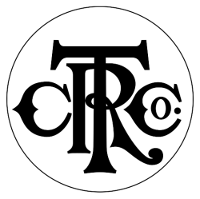
The Computing-Tabulating-Recording Company (CTR) was a holding company of manufacturers of record-keeping and measuring systems; it was subsequently known as IBM.
Paper data storage refers to the use of paper as a data storage device. This includes writing, illustrating, and the use of data that can be interpreted by a machine or is the result of the functioning of a machine. A defining feature of paper data storage is the ability of humans to produce it with only simple tools and interpret it visually.
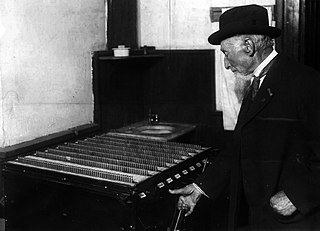
John McTammany was a Scottish-born American inventor who is credited with a number of patents. He immigrated to the United States as a teenager and served in the American Civil War.
A ballot marking device (BMD) or vote recorder is a type of voting machine used by voters to record votes on physical ballots. In general, ballot marking devices neither store nor tabulate ballots, but only allow the voter to record votes on ballots that are then stored and tabulated elsewhere.


